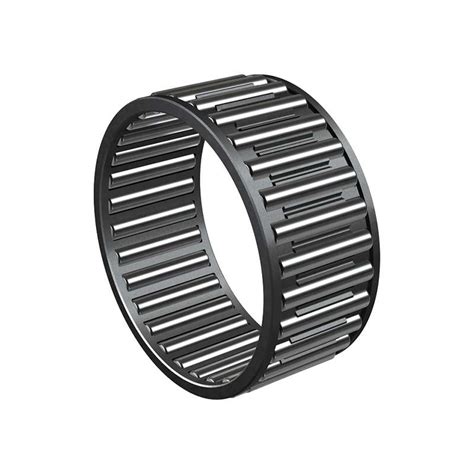Needle Roller Bearings: The Powerhouse of Precision
As the cornerstone of countless mechanical marvels, needle roller bearings have revolutionized industries with their unparalleled performance and reliability. From high-speed machinery to heavy-duty vehicles, these exceptional bearings play a pivotal role in enhancing efficiency, durability, and longevity.
1. Anatomy of a Needle Roller Bearing
At the heart of a needle roller bearing lies a cylindrical outer ring, an inner ring with a raceway, and a complement of cylindrical rollers (needles) that roll between the raceways. These rollers are slender and elongated, providing a large contact area for exceptional load capacity.
2. Types of Needle Roller Bearings
Needle roller bearings come in a diverse range of types to cater to specific applications:

-
Drawn Cup Needle Roller Bearings: Utilizes a thin-walled outer ring, drawn from steel sheet, for compact design and high load capacity.
-
Shell-Type Needle Roller Bearings: Features a two-piece outer ring, providing easy axial assembly and disassembly.
-
Thrust Needle Roller Bearings: Designed to handle axial loads, with rollers arranged in a cage for precise positioning.
3. Key Features and Advantages
Needle roller bearings offer a remarkable array of benefits:
-
High Load Capacity: Compact size coupled with a large number of rollers ensures exceptional load-bearing capabilities.
-
Low Friction: Precisely manufactured rollers and smooth raceways minimize friction, reducing power loss and wear.
-
Long Service Life: Durable construction ensures extended operating life, even under demanding conditions.
-
High Speed Capability: Optimized geometries enable high-speed operation, reducing vibration and noise.
-
Small Cross-Section: Compact design allows for space optimization in constrained applications.
4. Applications in Diverse Industries
Needle roller bearings find widespread use in a myriad of industries:
-
Automotive: Automotive transmissions, steering systems, and engine components
-
Industrial Machinery: Material handling equipment, machine tools, and textile machinery
-
Medical Equipment: Surgical instruments, imaging systems, and patient positioning devices
-
Aerospace: Landing gears, actuators, and control systems
5. Factors Influencing Selection
Choosing the right needle roller bearing for an application requires careful consideration of several factors:

-
Load Capacity: Determine the load requirements, including radial, axial, and combined loads.
-
Speed: Consider the operating speed and select bearings designed for appropriate speed ranges.
-
Lubrication: Choose bearings with proper lubrication systems to ensure optimal performance and longevity.
-
Environment: Evaluate environmental factors such as temperature, humidity, and potential contaminants.
6. Common Mistakes to Avoid
To ensure optimal performance and longevity of needle roller bearings, certain common mistakes should be avoided:
-
Overloading: Exceeding the specified load capacity can lead to premature bearing failure.
-
Improper Lubrication: Inadequate or excessive lubrication can compromise bearing performance.
-
Corrosion: Exposure to corrosive environments can damage bearing components, reducing service life.
-
Misalignment: Misalignment during installation can cause uneven load distribution and premature wear.
7. How to Install Needle Roller Bearings: A Step-by-Step Approach
Proper installation is crucial for ensuring the longevity and performance of needle roller bearings:

-
Clean and Inspect: Clean all components thoroughly and inspect for any damage or defects.
-
Prepare Housing: Ensure the housing bore is clean and free of burrs or imperfections.
-
Apply Lubricant: Lubricate the bearing and housing as per manufacturer's specifications.
-
Insert Bearing: Carefully insert the bearing into the housing, tapping gently with a soft-face hammer if necessary.
-
Install Shaft: Insert the shaft into the bearing, double-checking alignment.
-
Secure Bearing: Retain the bearing using appropriate methods, such as snap rings or retaining rings.
8. Why Needle Roller Bearings Matter
Needle roller bearings are not just components; they are the backbone of countless mechanical systems, enabling:
-
Increased Efficiency: Reduced friction and power loss contribute to enhanced efficiency in machinery.
-
Enhanced Durability: Robust construction and high load capacity ensure extended service life, reducing maintenance costs.
-
Compact Designs: Space-saving designs allow for optimization of space in compact applications.
-
Operational Flexibility: High speed capability, low friction, and compact form factor make needle roller bearings versatile for various applications.
9. Interesting Stories and Lessons Learned
-
The Tale of the Overloaded Bearing: A machine operator repeatedly overloaded a needle roller bearing, causing premature failure. The lesson: Respect the load capacity limits to avoid costly downtime.
-
The Lubrication Blunder: A technician incorrectly lubricated a needle roller bearing, using too much grease. This resulted in churning and overheating, leading to premature wear. The lesson: Follow manufacturer's lubrication instructions precisely.
-
The Misaligned Machine: Misalignment during installation caused a needle roller bearing to experience uneven loading and excessive vibration. The lesson: Ensure proper alignment to prevent premature bearing failure.
10. Conclusion
Needle roller bearings stand as a testament to precision engineering, enabling exceptional performance and durability in a wide range of applications. By understanding their unique features, selecting the right bearing for your needs, installing it properly, and avoiding common pitfalls, you can harness the power of these extraordinary bearings to enhance the efficiency, longevity, and reliability of your mechanical systems.

References
Requested Tables
Table 1: Needle Roller Bearing Types and Characteristics
| Type |
Features |
Advantages |
| Drawn Cup |
Thin-walled outer ring |
High load capacity, compact design |
| Shell-Type |
Two-piece outer ring |
Easy assembly and disassembly |
| Thrust |
Rollers arranged in a cage |
Handles axial loads |
Table 2: Needle Roller Bearing Performance Parameters
| Parameter |
Description |
Unit |
| Load Capacity |
Maximum load the bearing can support |
Newtons (N) |
| Speed |
Maximum rotational speed |
Revolutions per minute (RPM) |
| Friction |
Resistance to motion |
Coefficient of friction |
| Service Life |
Expected operating life |
Hours (hr) |
Table 3: Industries Using Needle Roller Bearings
| Industry |
Applications |
| Automotive |
Transmissions, steering systems, engines |
| Industrial Machinery |
Material handling, machine tools, textile machinery |
| Medical Equipment |
Surgical instruments, imaging systems, patient positioning devices |
| Aerospace |
Landing gears, actuators, control systems |

